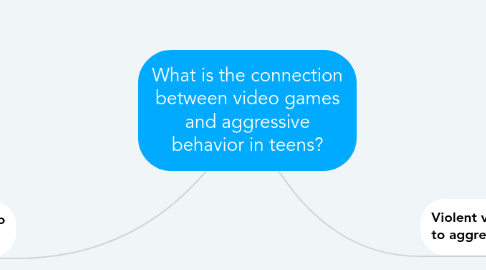
1. Video games are not linked to aggressive behavior in teens.
1.1. Andrew Leonard, a tech reporter and staff writer at Salon, argues that while some games are violent, there are lots of games that are not violent, and he says that games that encourage collaboration and community" are becoming become more commonplace (Leonard).
1.1.1. Leonard reports that his ¨son and his friends spend hours in the cooperative, creative world-building domain of ´Minecraft´ or chuckling their way through humor-drenched indie games like ´Don't Starve,´¨ and that ¨the explosion of mobile and social gaming has sucked all genders and ages into the gaming domain¨ (Leonard).
1.1.1.1. This means that when you play a game is fun to do like Minecraft it does not show any aggressive behavior.
1.1.2. Leonard also tells a story about a game his son likes to play in which ¨the games ... clear intent was to use gaming as a narrative vehicle to show how our new digital ways of play plug into the oldest stories that we've always told about each other¨ (Leonard).
1.1.2.1. This quote shows that is teaching about life in reality versus playing games in a computer.
1.2. Because there are many different kinds of video games that are not violent, but some other ones they do.
1.3. Eric Kain, a writer that writes technology and video games for Forbes, argues that whether or not video games can cause aggression are not clear: other nations also play violent games, but they never have mass shootings in the the US (Kain).
1.3.1. Kain points out that while one metastudy done in 2010 showed a relationship between gaming and violence, ¨results from another metastudy showed that most studies of violent video games over the years suffered from publication biases that tilted the results toward foregone correlative conclusions¨ (Kain).
1.3.1.1. This shows that many violent video games does not make people violence when you play a game.
1.3.2. Kain further restates the problem by pointing to a study performed in 1984 that claimed that games lead to physical aggression and then to a study performed one year later that ¨found that arcade games have a "calming effect" and that boys use them to blow off steam¨(Kain).
1.3.2.1. This means that if you play arcade (classical) games can calm you down than playing video games in a console.
1.4. Because not everywhere in the world play shooting games, but it does have violent video games, in their own way.
2. Violent video games are linked to aggressive behavior in teens.
2.1. Video games are associated with problems for drug use to poor relationships that are affected to violent video games in a high tolerance of pain (Flanagan).
2.1.1. Flanagan states "that the brains from the gamers change their act depending on what game they play, which means, violent video games are linked to the entire real world" (Flanagan).
2.1.1.1. It means that aggressive behavior makes gamers acts differently from whatever game it plays.
2.1.2. Flanagan explains that "they wanted to show that "nice" games makes people nicer, and it demonstrates that the wealth of information ties to aggressive video games are into anti-social behavior" (Flanagan).
2.1.2.1. This makes me think that it wants to show evidence by comparing violent and nice video games.
2.2. Because by whatever violent game they play, their behavior changes and acts weird and a bit differently because of your brain and researchers think that nicer games would make people act nicer.
2.3. Educators are used by their same techniques to teach children to play violent video games (Thompson).
2.3.1. Thompson says, "before the Congress in June 2000, there was a direct causal link between violent video games and violence and many various medical research facilities have found that teens process of violent images have different parts of the brain than do adults" according to Howard (Thompson).
2.3.1.1. It matters that video game games is causing to violence and there are totally different from our parents.
2.3.2. Thompson says that "a Gallup Poll found that they are twice as likely to engage of acts of violence than those who never played the game Grand Theft Auto, and it was recently found that 71 percent of teen-age boys have played Grand Theft Auto series" (Thompson).
2.3.2.1. This connects a little of evidence that many teenagers have played violent games like GTA (aka Grand Theft Auto) than to the one that it in the article.

